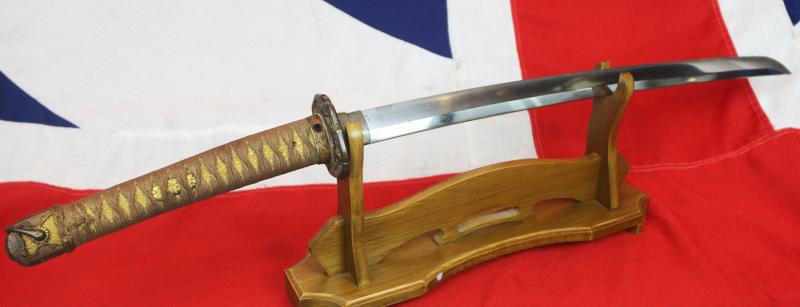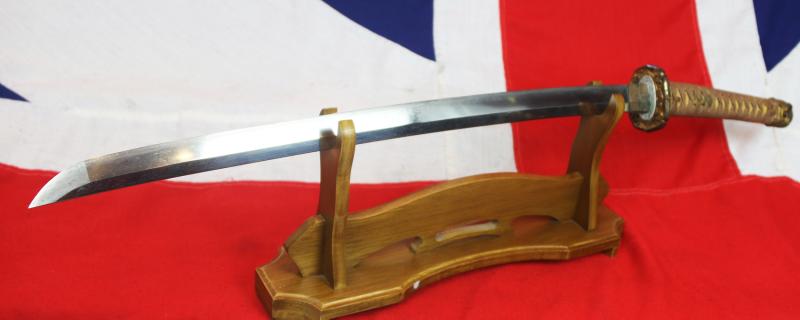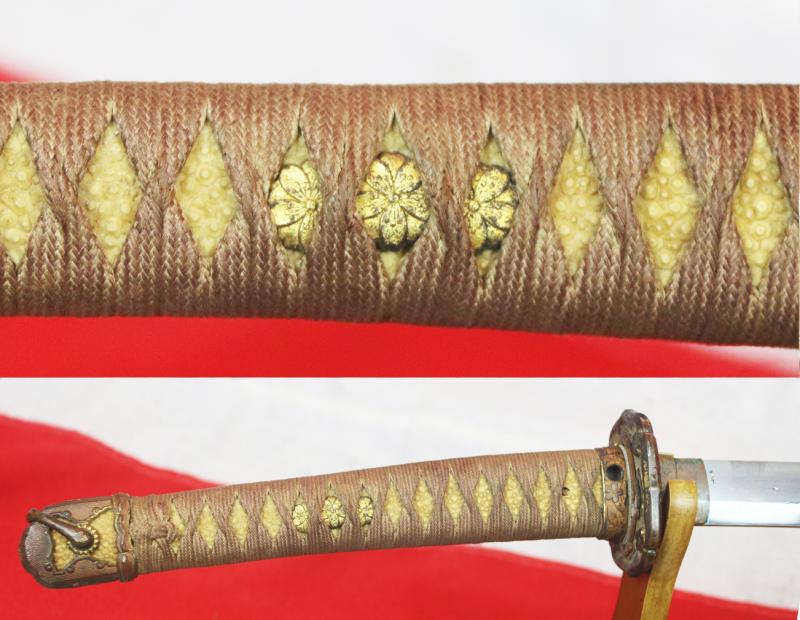Antique 'Ancestral' Blade of 400 to 500 Years Old Katana in WW2 Japanese Officer's Regulation Type 98 Mounting For WW2 Officers. With A Fine & Unusual Extra Light Weight Alloy Scabbard. Possibly For A Flying Officer.
This has lain in a family ownership since 1945/6 since its return as a surrendered sword from the Imperial Japanese officer to whom it formerly belonged, in the service of his emperor. Ideal, for a collector of such historic and desirable Japanese swords of WW2 but with an ancient ancestral blade of hundreds of years of age.
Shinogi zukuri with high ridge line and very narrow mitsu mune. The saya is traditional green lacquer painted very lightweight alloy with brass type 98 fittings, single belt suspension ring and semegane; It has a tsuka of traditional wood wrapped in beige silk cloth Ito over white samegawa (ray skin), standard 38 pattern brass military mounts including fuchi, tsuba with, kabutogane with sarute in metal with sakura and menuki decorated with sakura and chrysanthemums. The regulation saya retaining press button in the fuchi has been removed by the Japanese officer as is very often the case {see photo 7}. The button clip was designed to hold the blade within its saya {scabbard} while ‘on the run” so to speak. This was a technical safety advantage, however, officers trained in iaido {the traditional martial art of the drawing of the sword from its saya} had no such fitting on regular katana, and the button could cause a millisecond or even more of delay in combat, which by traditional swordplay standards is not only unacceptable it was also, potentially, a fatal drawback and disadvantage to the swordsman. Thus, they often removed and discarded this feature from the sword entirely.
The ancestral blade was made from around 1550 to 1620, and thus this sword would have seen service by up to 20 samurai, plus the WW2 officer within it's combat lifetime. Then, by its very last owner it was mounted and taken to war by likely the eldest son, likely a pilot, from a family with old samurai heritage.
This sword has pretty much remained untouched for 75 years, and looks just as it did when, for example it was removed from the standing plane's cockpit. The Japanese combat planes often had a metal container within the cockpit that would hold the pilot's combat katana or wakazashi. Although the pilot was never expected to likely need his sword while on a mission, he was expected to die with it if his plane should crash or explode, and if his plane was to crash land, and he survived, he would have his officer's sword to maintain his life in potential enemy territory.
The blade has a stunning hamon and in jolly nice polish, that is just being lightly cleaned at present, then it will be re-photographed. A likely Crew Gunto mounted sword, with an early Koto to Shinto period ancestral chisa katana blade in a slighty grubby polish {at present} showing a fine and active hamon. The whole sword is simply in super condition for it's age. The blade is set with its all traditional WW2 38 pattern Showa brass fittings, a fine tsuba with its green lacquered metal saya with all traditional brass mountings. It may well be known as a crew-gunto and carried by a Japanese fighter pilot from 1936 until 1945. The shorter military mounted swords, or those in very light weight saya, worn during WW2 for those that fought, during combat, such as a bomber or a Zero fighter plane.
Photo in the gallery shows Kamikaze pilots getting into their planes, and photos of the Kaiten ceremony. Another two photos of Japanese pilots with their crew gunto swords, for information only photos not included. Collectors frequently seek Shin Gunto swords that have an original handed down 'Ancestral' blade, as it is said less than one in a hundred Japanese swords, surrendered in WW2, were swords such as this. This form of sword was often the prerogative of an eldest born son, that went to fight for his Emperor in WW2, with his ancestor's blade set in traditional military mounts.
This sword is an exceptional piece of WW2 Japanese historical interest, very early ancestral swords are scarce in themselves, outnumbered at least 10 to 1 by gendaito swords, but the short 'crew gunto' are much rarer than even that, in our experience, so this makes it potentially, in theory, well over a 100 times scarcer than a regular Japanese WW2 officers sword in our opinion. Overall 38 inches long, blade 22.75 inches from tsuba to tip overall in super condition with overall finger staining, soon to be removed. The saya lacquer is around 85% intact but with small areas of loss.
Every single item from The Lanes Armoury is accompanied by our unique Certificate of Authenticity. Part of our continued dedication to maintain the standards forged by us over the past 100 years of our family’s trading, as Britain’s oldest established, and favourite, armoury and gallery
Code: 25339
3250.00 GBP










